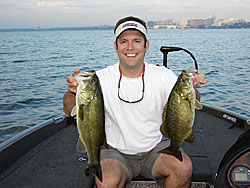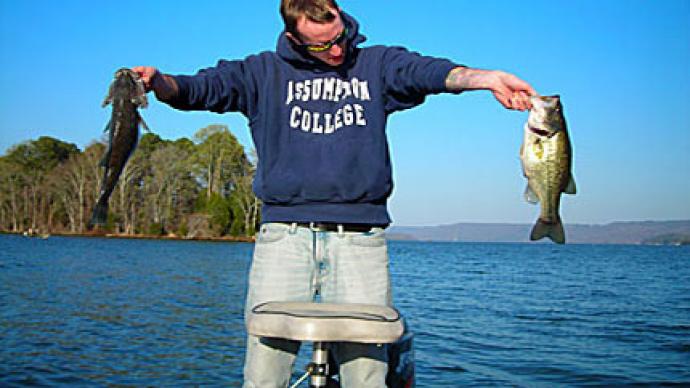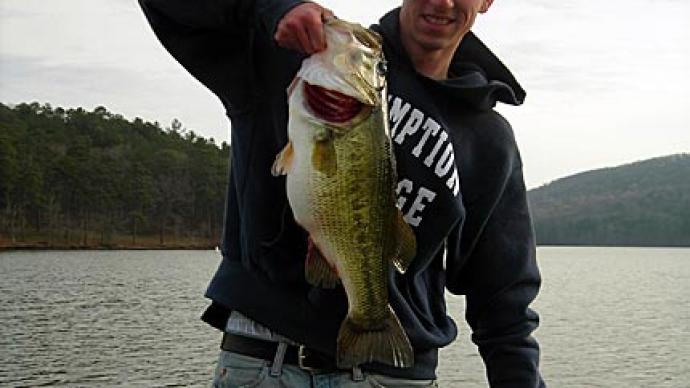
As springtime approaches this season, a bass angler's fancy turns to burning lipless crankbaits across fish-covered grass flats and speeding up and down the lake putting bass in the boat with disturbing speed. However, many anglers don't realize that some of the finesse presentations that work during the slower months can also put fish in the boat when fish are more active, such as in the spring. I say from experience that slowing down this spring and trying some lighter, more finesse-like presentations can put bass in the boat that other anglers might pass up with their higher speed approaches.
For the sake of instruction, I will cover some of the presentations and tactics that have paid off for me in the spring, in both tournament and recreational angling. The first of which is drop-shotting. It might not be the first tactic on the minds of anglers come spring, but there are certainly applications for it. A good example would be working a drop-shot rig off the first and second drop-offs when big fish are preparing to move up to their spring spawning spots.
One of the more popular approaches to a situation like this might be a crankbait or perhaps a fast-moving spinnerbait. Still, when you understand what a drop shot rig does, you realize it's almost custom-tailored to this particular situation. By fishing the drop-shot on these ledges and shelves adjacent to spawning beds, you do what a crankbait does, only better.
When fishing cranks or spinnerbaits, the lure is only down in the strike zone for a minute or two, depending on the speed at which the angler works the bait. However, with a rig such as the drop-shot, you can specifically target hot spots on those drops offs and shelves, and you can leave the bait in the strike zone indefinitely, which is the advantage of a drop-shot in the first place.
This tactic is usually associated with deeper water but can be used in nearly any depth. Long Island fluke and flounder anglers who have been using a similar rig for years will tell you that no matter the water depth, the idea of suspending the bait above the sinker will most certainly be practical.
One of my favorite drop-shot rigs is a bacudan sinker with a pull-away knot design. Should you snag the sinker, the rest of the rig will pull away, giving you the ability to save time by simply attaching another sinker rather than retying the entire rig. I prefer a 1/16- to 1/8-ounce sinker, depending on the depth I am targeting and on surface conditions such as wind.

As for the bait, my weapon of choice is the two- and two ½-inch Robo Worm drop-shot baits, complete with an internal rattle, rigged on a Daiichi drop shot hook, with Bleeding Bait red finish, in either a size #4 or #6, which I match to the size of the bait I will be using. One of the advantages of using the Daiichi drop-shot hooks, as you can see in the picture, is the gap allows either nose-hooking a bait or rigging it conventionally on the hook. Also, the added flash and flare of a red-tinted bait, which is one of my favorite springtime colors, in conjunction with the red flash of the hook, seems to put bass in that mood that we love so much, which I call "seek and devour."
By targeting bass come springtime with a drop-shot rig, I can guarantee that you will be cashing in on many of the fish that an angler using a speedier presentation will most certainly pass by.
One final hint I might add is getting a hold of a good contour map to locate likely spawning areas adjacent to the shelf-style contours mentioned above. Also, some scouting might be in order before the spawn starts to pinpoint areas where this type of presentation will be most effective.
Another great way of lightening up the tackle to target spring bass is a modified version of what has been my all-time favorite rig as of the last two seasons. That's the weightless worm.
Either a four or six-inch worm, preferably one with a smaller profile, has caught more fish for me than I care to attempt to count. However, I now realize that this tactic can also be a sure-fire fish catcher come spring with a few minor modifications.
I devised this rig using input from a good friend in Massachusetts, biology major, and avid angler Mike Byrne. After a brief lesson in fish behavior, he informed me that not only will fish defend a spawning bed, which we all know, but they will also attack potential nest predators during the pre-spawn. This got the gears whirring in my head about how I could cash in on this little quirk that bass have. It so turns out that many fish will attempt to rid the area of potential predators, as so when they begin to spawn, the area will be free from nest raiders.
A quick side note to non-bass anglers, this behavioral attribute applies to nearly every freshwater species, not only bass. We concluded that the top bass nest predators, small lizards, and crawfish would be struck far more often than, say, a worm presentation, which was the original bait of choice in the weightless rig that I mentioned earlier. So come springtime, my first modification to this rig is to forgo the worm mentioned above and use a smaller craw or salamander imitation instead.
Once again, bass anglers know that your average craw is a bottom-dwelling creature, as are most small lizards. This made me realize that a mid-water column free-suspending rig will not get the job done here. I needed something to stay to the bottom but not sit there like a brick. That would be when we both had the same idea simultaneously.

The only way to change the fall rate of a weightless rig without using sinkers was to change the hook. When fishing this rig in the spring, I make it a point to use a far heavier hook that I would use when fishing the summertime worm tactic.
An example of this would be to go from a regular hook to a heavier flipping hook of the same size. The hook's added weight brings the bait to the bottom and allows the bait's action to remain unimpeded and give it the free-moving finesse look that puts the bass in the well.
I beg you to try this rig come spring on your favorite lake and see for yourself just how effective it is. I even went so far as to tank test this idea and saw how subtle the fall, and just how lightly the bait remained in contact with the bottom, which is precisely what the real deal as far as craws and lizards do.
As I mentioned earlier, getting this bait in and around potential spawning locations will lead to reaction and defensive strikes.
As for both presentations, be prepared for fast, however not hard strikes. Being a line watcher here will pay off in your favor. You will often not feel rather than see the strike through the line.
Fishing this rig in and around pre-spawn fish, in optimally 5- to 8-feet of water will again, as the drop-shot will, pick up fish that many of the anglers throwing movement-based baits will undoubtedly pass up. Just something to keep in mind when you wonder where all the active fish went on your favorite spot.
One thing I did not cover yet is line weight. I would go no heavier than an 8-pound test with the drop-shot and modified craw rig. Keeping down the line signature will also pick up fish suspicious of plastic imitations and keep the action of the baits natural. I use a 6-pound test Izorline because the line signature is kept to a minimum due to the smaller diameter.
Keep in mind these light presentations this springtime, and also, don't be afraid to try your favorite light tackle presentation, changing only the location where you are employing it. Then you can watch the jaws drop at the scales or the ramp when anglers ask where you caught your fish, and you tell them it was in the same spot they were fishing! You, as Emeril says...kicked it down a notch.
Catch you on the water...




